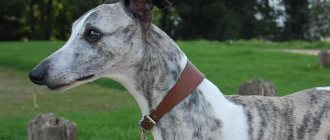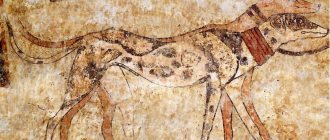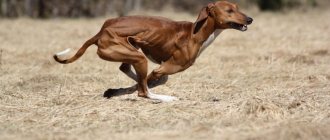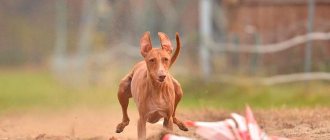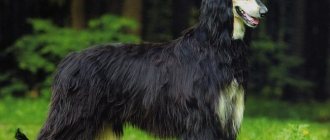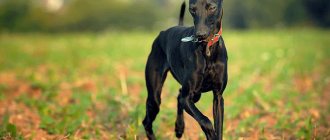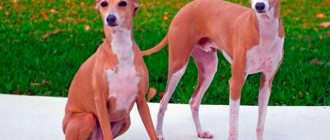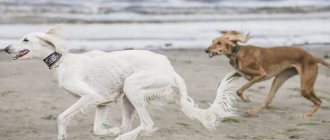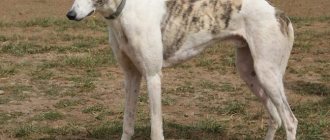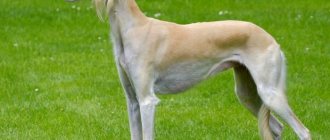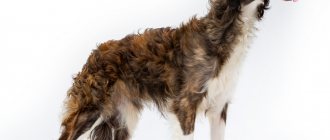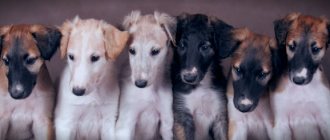Description of the Podenco Ibicenco breed
Popularity 43rd among 263 dog breeds
Lifespan:
10-12 years
Breed group:
Greyhounds
Height:
males: 66-72 cm, females: 60-67 cm
Country of origin:
Spain
Average price:
50-150 thousand rubles
Weight:
males: 20-25 kg, females: 18-22 kg
Latest articles Cat health
Ataxia in cats: what it is, how it manifests itself and is treated 01/23/2022 169 0 0
Cat health
Leukemia, or viral leukemia in cats 01/23/2022 151 0 0
Photo
Photo: wikimedia.org
Photo: wikimedia.org
Photo: wikimedia.org
Photo: wikimedia.org
Photo: pixabay.com
Photo: pixabay.com
What do you know about such a rare breed? Which of our readers has such a pet at home? Please tell us about your content experience.
Key facts
The Podenco Ibicenco is a loyal and friendly breed that has great love for the people around it. The Ibizan dog is suitable for owners who prefer an active lifestyle, because the animal requires a lot of physical activity.
The exotic-looking dog is an excellent hunter thanks to its well-developed vision, hearing and sense of smell. It works especially successfully in a large flock of 10-12 individuals.
The animal is a silent and clean pet. This allows you to keep them in a city apartment. The only condition for their comfortable existence should be long walks with a sufficient level of physical activity.
Life expectancy and major diseases
Podenco Ibicencos suffer from colds quite rarely. But still, some diseases can cause serious problems, and many of them are congenital. Most often this is:
- convulsions,
- cataract,
- deafness,
- allergy.
In addition, the dog tolerates anesthesia very poorly - it should be done only in extreme cases.
Vaccinations
Also, when picking up a pet from a kennel, it is important to have all the necessary vaccinations - the list is exactly the same as for any other dogs: distemper, rabies, and against worms. Revaccination - every year.
History of the origin of the Podenco Ibicenco breed
The circumstances of the appearance of representatives of a rare breed today are covered with the dust of centuries. The only thing that scientists were able to establish with accuracy was the time when Podenco Ibicenco was already known. And then – the spread here is quite large.
“ Experts say that 3-5 thousand years ago, the ancestors of the greyhound already existed and helped their owners during the hunt.
Among several versions of the appearance of the animal, the most popular is the Mediterranean one. The Ibizan Hound is believed to have descended from ancient Egyptian dogs. These individuals existed during the time of Tutankhamun. Their images, by the way, are on the walls of ancient pyramids.
Another version also deserves attention. Thus, dogs of the Podenco Ibicenco breed came to the Spanish island of Ibiza at the end of the last era. They arrived on Phoenician ships and were in demand by the local population due to their excellent rabbit hunting skills.
And the latest version, the “freshest”. Some suggest that the Ibiza Greyhound was the result of crossing several representatives of hunting breeds. Moreover, the breeding process took place relatively recently, in 1963: then the Pharaoh Hound was born.
And only in 1982, due to confusion among breeders, the name changed. This is where pets with an unusual appearance received the sonorous name Podenco Ibicenco.
Whatever the origin story is true, only one thing is known for sure: representatives of the breed have always been used for hunting. They were collected in flocks of 10 to 15 individuals. When an animal was discovered, the leader gave a voice, and all the other dogs surrounded the victim.
“Bitches have always been considered the best companion hunters. The independent nature of male dogs forces them to hunt separately from the owner and the entire pack.
It is quite difficult to meet representatives of the Ibiza Greyhound in Russia. This breed is not common among hunters, although there are breeders who prefer the Ibicenco Podenco to any other dog.
Advantages and disadvantages of the breed
Podenco Ibicencos are mischievous, playful little pranksters with a cheerful, balanced disposition. They are not suitable for those who like to lie on the couch, as they require a lot of movement. These are wonderful companions for lovers of cycling or outdoor activities.
Despite their suspicion of strangers, good-natured Podencos are unlikely to make strict guards. They are very affectionate and loving
Most often, their love is directed towards children, and it doesn’t matter whether they are their own or someone else’s. And if there are other animals in the house, then from the first days it is necessary to accustom the mayfly to their presence so that the dog does not perceive them as prey
But despite this, cats and birds will always be at risk
But despite this, cats and birds will always be at risk.
These are very smart dogs that can learn quickly and easily. But they are also prone to independence and independence, even to the point of completely ignoring commands. For this reason, Podencos require good early training.
These dogs captivate with their grace and nobility. They will not get underfoot and can sense the owner’s mood well. If you are lucky enough to become the owner of a Podenco, then your love for this breed will remain with you for a long time.
Appearance Podenco Ibicenco
General impression
Despite the fact that the history of the breed may go back centuries, breed standards appeared not so long ago. When looking at these amazing animals, it is obvious that these are extraordinary creatures with striking external characteristics. Once you see a dog of this species, you will no longer confuse it with other breeds. The animal has truly aristocratic appearance and innate elegance. Although there is something funny about it.
Head
The skull has a cone shape. The head is small in size, proportional to the body.
Nose, eyes and ears
The animal's eyes are small and slightly slanted. The iris should be colored a bright amber shade.
The ears are slightly disproportionate. According to standards, they must constantly be in a standing position. The ears are not cropped, so they appear too large against the background of a small head.
The pet's nose is large and flesh-colored. Moreover, the lobe can be colored completely or partially.
Teeth and bite
Podenco Ibicencos are the happy owners of strong, snow-white teeth. According to the standard, they should have a scissor bite. The dog's jaws are powerful.
Neck
Despite the fact that the neck region of the Ibizan Hound is quite thin, this part of the body is covered with strong muscles. The neck itself is thin and gracefully arched.
Torso
The body of the Ibizan Hound has an elongated shape. An athletic physique is possible thanks to a well-developed muscle corset. The muscles covering the dog's body are flat in shape. They are very strong and elastic.
The animal's ribs are convex, but the chest bone, on the contrary, is sharp. The chest has a deep, pronounced shape. The back is strong, without any arching.
Forelegs
The greyhound's paws are powerful, with good bones. The forelimbs are long and thin. They are located close to each other.
Hind limbs
The hind limbs are covered with strong muscles. They are located close, which allows the dog to make confident movements while running. The pet's fingers are closed. There shouldn't be any profit.
Tail
The tail section is completely covered with hair that is rough and prickly to the touch. The tail itself is long and very mobile. It has a thick base that turns into a thin and sharp tip. The tail itself is low.
Movements
The Ibizan dog moves by gracefully rearranging its hind and forelimbs. Thanks to powerful muscles and strong bones, the animal can cover long distances. And when jumping, it seems that the dog is hovering above the surface of the earth.
Wool
Ibizan greyhounds can have two types of coat: short and long. The former have coarse body hair. In long-haired individuals, the coat is long but hard. A small beard may form on the muzzle.
Color
Ibizan comes in white and/or red color. In this case, shades from very light to dark red are allowed.
Size
Adults reach a height of 58-70 cm, depending on gender. Weight can range from 20 to 27 kg.
Disqualifying faults
Among the main disqualifying faults are a square physique with thick limbs.
Dewclaws are a deviation from the standard and should be removed at an early age. The dark color of the iris and nose is also considered a disqualifying defect.
Appearance - color and size
Features of the breed are that the dog is tall. In adult males and females, it reaches 74 cm at the withers. The dog's weight ranges from 19 to 25 kg. Long-haired dogs have hair up to 2.5 cm long. It covers the head and is the softest.
Wire-haired pets have short, coarse and close-lying hair. Most species have a beard. The short-haired type of dog has a smooth and coarse coat. Representatives of the breed are white or red in color. The description indicates that some dogs may be red and white in color.
Character of Podenco Ibicenco
The animal has a good-natured and very cheerful character. However, a lack of physical activity (and the Ibizan requires quite a lot of it) can lead to problems with the pet’s mental health. Such changes will negatively affect his character.
“ Full of energy, the dog displays funny behavior both outside and at home. He loves to be the center of attention, so he will be the life of any company.
The best option for keeping dogs from the island of Ibiza is a private house with free access to the yard.
Despite the fact that dogs are wary of strangers on their territory, they make poor guards. Podenco Ibicencos do not like to bark at all.
They try to make any sounds only when absolutely necessary. This feature makes the pet an excellent option for living in a spacious apartment. A silent dog is unlikely to disturb the neighbors with its constant barking.
The Ibizan Greyhound gets along well with all family members. However, it is better not to leave her with very young children - the kids may offend the pet.
The dog does not really like the presence of cats, rodents or birds nearby. They will be perceived by the greyhound as prey.
For the same reason, you should not let your pet off the leash while walking within the city. But far from a populated area, the animal happily runs around open spaces. Thanks to its excellent sense of smell, the dog does not get lost if it runs some distance from the owner.
Owner reviews
Ekaterina O.
I saw a dog for the first time in Spain on vacation. I got the idea to buy such a beautiful dog. The matter turned out to be problematic - it was expensive, the wait was long, and there were few nurseries in Russia. I managed to buy a “mayfly” in Spain. The older he became, the clearer it was that we couldn’t cope with him. There is no time to walk for a long time; the plot near the house is not enough for him. He drove all the cats and almost ate one. He was simply going crazy from the lack of energy release. They gave the boy to a hunter friend. He feels good there. He has become calm, knows all the commands, and adores his new owner and his children. Don't look at the dog's appearance, consider his nature as a hunter.
Max Z.
When I bought such a dog, I knew what I was getting into. Buying such a dog is an expensive matter, you need to approach the issue responsibly. I'm not a hunter, but I found something for my Tessa to do. We take part in coursing, my dog runs after a mechanical hare and wins competitions. After each race he seems to smile with joy.
At home – a devoted, affectionate, calm dog. In everyday life she is not picky, she is unusual - on the street many eyes are drawn to us.
Education and training
The Ibizan should be socialized immediately after entering the home. The puppy responds well to his owner’s commands, so he easily adapts to living with a family.
From an early age, the puppy should be taught to walk on a leash. This is especially important for the further socialization of the dog, when the animal will walk with the owner along the city streets.
You can train a dog yourself, without the involvement of an experienced trainer. However, a general course or a city dog course will be equally beneficial for exotic individuals.
Representatives of the breed are very smart creatures, with excellent memory. They quickly remember human orders. Sometimes just a glance is enough for the pet to understand the owner’s wishes.
In any case, training must be carried out regularly. Commands should be spoken in a firm and assertive voice. As with any other dog, the Ibizan Greyhound should not be raised or hit.
Breed traits
Breed traits (on a 5-point scale)
| Ibizan Greyhound | |||
| Activity | in the house | 3 | |
| on the street | 4 | ||
| Obedience | training | 4 | |
| strangers | 4 | ||
| Domination | in family | 2 | |
| over dogs | 2 | ||
| Defending your territory | from people | 3 | |
| from dogs | 3 | ||
| Sociability | in family | 3.6 | |
| with strangers | 3 | ||
| with dogs | 3 | ||
| Concentration | in family | 1.2 | |
| in front of strangers | 2 | ||
| with dogs | 3 | ||
| Aggressiveness | in family | 2.8 | |
| to strangers | 3.5 | ||
| to the dogs | 3 | ||
| to cats | 3 | ||
| Family behavior | calmness | 2 | |
| demand for affection | 3 | ||
| excitability | 4 | ||
| playfulness | 3 | ||
| excessive barking | 2 | ||
| behavioral breakdowns | 3 | ||
| Tolerance for children | up to 4 years | 3.5 | |
| over 4 years old | 3.7 | ||
| Institutional use | watchman | 3.5 | |
| bodyguard | 2.6 | ||
This breed is often compared to the following dog breeds: Wirehaired Pointer Griffon (Griffon Corthals), Saluki (Persian Greyhound), Belgian Laekenois Shepherd, Irish Water Spaniel, Pharaoh Hound.
The photo shows what these dogs look like:
Health and disease of Podenco Ibicenco
Possible diseases
Ibizan is the happy owner of good health and good immunity. However, without proper attention from the owner, the physical condition of the pet may deteriorate. It is important to regularly carry out vaccinations, deworming and treatment for skin parasites.
Future owners need to know about diseases to which Podenco Ibicencos are predisposed:
- allergic reactions associated with improperly selected diet or care products;
- cataracts, which are accompanied by significant visual impairment;
- hearing problems, most often congenital;
- retinal dysplasia is also a hereditary disease associated with abnormal development of the retina;
- epileptic seizures, causing convulsions and involuntary urination.
Long hind and front limbs can be easily injured. Therefore, you need to monitor your pet’s physical activity.
In addition, dogs of this breed have problems with thermoregulation. It is difficult for them to tolerate sudden temperature changes. Severe cold or heat has a bad effect on the physical condition of pets.
Reproductive health and breeding
The optimal age for the first mating of dogs is 2-2.5 years. It is then that individuals of both sexes are ready to reproduce healthy offspring. An earlier mating will lead to negative consequences for the mental and physical state of the bitch. It is best to carry out mating in the male dog’s territory.
During pregnancy, you need to provide the female with good care. You can deliver the baby yourself, but keep the veterinarian’s phone number handy. If breeding is not planned, the bitch is spayed at about one year of age.
Attitude towards children and pets
Podenco Ibicencos build quite friendly relations with children. This dog will not become an exemplary nanny, and he will not want to spend many hours in games - after all, this is not what the breed was bred for. But the possibility of conflicts between them is quite low
This breed has a difficult relationship with pets. Conflicts with dogs are quite rare. But still, it is advisable not to get new pets in a family that already has an Ibicenco Podenco - it is better, on the contrary, to add this puppy to the existing pack. But this hunting dog regards hamsters, cats, guinea pigs and other small animals only as prey that urgently needs to be caught and brought to the owner.
Features of feeding and diet
Due to the fact that representatives of the Podenco Ibicenco breed can well regulate the amount of food they eat, they are not prone to overeating. The main task of the owner is to organize a balanced diet for his four-legged friend.
The dog's food must contain a sufficient amount of microelements and vitamins. Industrial super-premium or holistic-class food already contains the additives necessary for the healthy development of a dog. If the diet of a long-legged pet consists only of “drying”, then you should choose a product labeled “for active animals”.
When feeding naturally, you need to carefully think through the menu. The animal's diet should contain:
- lean meats and offal;
- cereals (buckwheat, rice);
- vegetables, boiled or raw, chopped;
- eggs (no more than 1-2 per week);
- low fat dairy products.
You should not give your greyhound river fish, sweets, baked goods, grapes or citrus fruits, salted or smoked foods.
With any type of nutrition, the dog must be provided with unhindered access to clean drinking water.
Nutritional Features
The owner can choose the diet himself. Some people prefer dry food. But it is worth considering that the food must be of high quality and suitable for active dogs. Therefore, cheap varieties are not suitable.
Other breeders prefer to feed their pet homemade food. It costs less and the owner knows exactly what his dog eats.
The basis of the diet is meat. Lean meat (beef, rabbit, poultry) is better suited. Several times a month you can give sea fish, but without bones. In half of the cases, meat should be replaced with kidneys, heart and liver - they are rich in useful microelements. It is best to boil the meat and then cut it into small pieces.
Porridge is cooked in meat broth. It is advisable to use cereals such as millet, oatmeal and buckwheat. It is a source of carbohydrates and microelements.
Finally, you should grate raw vegetables into the porridge - carrots, pumpkin or zucchini. They will provide your dog with many vital vitamins.
Care and maintenance
Hygiene and grooming
The exotic pet takes care of its cleanliness on its own. This means that caring for your four-legged friend is not at all difficult. However, to maintain the unusually elegant appearance of the animal, the owner should:
- Brush weekly. For short-haired individuals, it will be enough to simply wipe them with a damp cloth periodically.
- Bath procedures should be carried out no more than once a quarter. For this purpose, a special shampoo is suitable that is suitable for the coarse coat of the Ibiza Greyhound.
- Veterinarians recommend trimming once a year.
- Nails should be trimmed as they grow. In active animals they can wear off on their own.
- Brush your teeth weekly. Veterinary paste and a special finger brush are well suited for this.
- The ears should be examined at least once a week. You can remove dirt using cotton pads moistened with warm water or a special solution.
- It is better to wipe and examine your eyes at least once every 1-2 days. Accumulated dirt should be removed with a damp cotton pad.
Caring for the Ibicenco may also not be difficult because the graceful animal is not prone to overeating. The four-legged pet is able to independently determine how much food it needs to eat. He leaves excess food in the bowl without regret.
Walking and activity
The best place to live for an Ibiza greyhound is a country house. In this case, the dog can spend a lot of time in the yard. The main thing is that the space is surrounded by a high fence.
The increased jumping ability of the breed allows the dog to jump over almost any obstacle.
“ Interestingly, the Ibizan tolerates loneliness quite well. The dog is ready to patiently wait for the return of his family members. However, only a pet that has had a good walk can be calm.
During promenades in the cold and dank season, your dog should be dressed in clothing appropriate to the temperature outside. But in hot weather, the owner is recommended to take a bottle of water with him. This will allow the animal to cool down and quench its thirst.
Veterinarians and breeders recommend walking your exotic pet at least 2 times a day. However, three walks a day would be an absolutely ideal option.
If you do not lead your greyhound on a leash, then in a noisy city you can lose it. Having seen prey - a cat, a bird, a rodent - the hunting dog sets off in pursuit of it. In this case, the owner is unlikely to be able to catch up with the four-legged pet. The speed of the Ibizan reaches 50-60 km/h.
Azawakhs in heat
- age of onset of the first estrus in a female is 6-12-14 months;
- duration of estrus is 20-22 days, sometimes up to a month;
- frequency of estrus – 1-2 times a year with an interval of 6-9 months;
- signs of estrus – swelling of the dog’s external genitalia, spotting;
- frequent urination - having to walk more often than usual;
- psychological signs - a change in the dog’s behavior - from aggressive to lethargic;
- perhaps there is a change in appetite and the dog drinks more water;
- often bitches begin to shed before going into heat;
- lick the loop intensively.
You can notice the approach of estrus while walking your dog. Behavior can change, often the dog becomes active, playful and disobedient, or, on the contrary, looks unhappy and lethargic. The bitch makes frequent marks - scent “lures” for male dogs, and urination occurs more frequently. The loop becomes more and more swollen; when pressed, you can see a discharge of light pink or dull pink color. If you notice changes in the dog's behavior, do not be lazy and check the dog every day for the onset of heat by dabbing the bitch's loop with a napkin or toilet paper. Pinkish discharge will be the beginning of estrus - mark this day in your dog’s notebook.
The course of the dog's first heat.
- The first heat in dogs is not the same as the next one.
- It may be shorter or longer than the usual estrus period.
- The bitch has either only weak manifestations of estrus, or, conversely, very heavy discharge.
- The first heat may suddenly stop, and then after some time begin again.
- There may be mucous discharge from the loop, a smell that attracts males, and the estrus itself will begin after some time.
- Try not to miss the start time of the first, and subsequently the second estrus, in order to correctly determine the intervals between estrus and know their timing and duration.
Precautions during estrus. If you are not interested in getting puppies from a dog, you need to take precautions during heat:
If you are not interested in getting puppies from a dog, you need to take precautions during heat:
- walk your dog ONLY on a leash: even the most obedient dog these days can simply run away, not paying attention to commands;
- do not allow male dogs to mount the dog: if sexual intercourse begins, it is almost impossible to separate them;
- during a walk, literally DO NOT take your eyes off the dog, even when buying bread in a tent, eliminate or minimize contact with male dogs;
- there is a danger of the dog catching a cold in the cold season, the best way to protect yourself is not to walk for a very long time in cold weather and use dog clothes;
- If your dog lives freely on your territory, then from the moment the estrus begins, lock the dog in an enclosure.
Tips for choosing a puppy
Since the Podenco Ibizan breed is almost not represented in Russia, it is quite difficult to purchase a purebred Ibizan. You should not buy a puppy from unverified breeders. In this case, you can buy an animal with disqualifying defects or hereditary diseases.
Before purchasing, be sure to look at the documents and pedigree of the puppy. It wouldn’t hurt to get to know the baby’s parents. They must have health certificates.
How to buy an Ibizan Greyhound puppy
Ibizan is almost unknown in Russia. This is a rare breed; kennels are found mainly abroad. To purchase a puppy, you must queue in advance. For breeding and an exhibition career, it is better to purchase a dog in Spain, in a professional kennel. Pets can be found from private breeders. Prices for puppies of this breed are about 1000-1500 dollars.
The photo shows what Ibizan puppies look like:
The video complements the description of the breed:
Video: Podenco Ibizan or Ibizan Greyhound or Ibizan. Pros and cons, price, how to choose, facts, care
The Ibizan is a wonderful companion for owners leading an active lifestyle and for families with children. He finds a common language with everyone, affectionate and sensitive. With proper training, this dog will be obedient and will not cause any problems.
Brief characteristics of the dog
- Other possible names : Ibizan Greyhound, Ibizan, Ibizan Hound, Balearic Italian Greyhound, Balearic Dog, Podenco Ibicenco, Galgo Greyhound, Ibizan Hound.
- Adult height : females from 60 to 67 cm, males from 66 to 72 cm.
- Weight: 20-30 kg.
- Characteristic color: red and white, white, red-yellow, red.
- Coat length: short, usually smooth, less often wire-haired. Long-haired is very rare.
- Life expectancy: 12-14 years.
- Advantages of the breed: dexterous, balanced, playful, intelligent.
- Breed Difficulties: Independent, prone to disobedience.
- Average price: Podenco ibicenco costs $500 on average.
Briefly about the nutrition of a puppy and an adult dog
Podenco Ibicencos can be quite picky when it comes to food . They will let you know with their looks and eyes what you like and what you don’t. Under no circumstances will they eat anything they don't like.
The best solution to this problem may be properly selected dry food . But its class should not be lower than premium, and the food must fully meet the needs of the animal. This means that for a growing puppy one type of correct balance is needed, but for an older dog it will be a little different.
The dog should be fed strictly according to the recommendations on the packaging. As for the puppy, if you are not able to feed him all the time as recommended in the nursery, the transition to a new food should occur within a few days. The same applies to changing food in general. Be sure to make sure your dog has water.
Since the Podenco is a fairly tall dog, it is best to feed it using an adjustable stand on which bowls of water and food are placed. They should be located at chest level.
Always remove the bowl before the next feeding 20 minutes after the start of feeding if there is food left in it.
What to feed
A young animal requires more vitamins and microelements for rapid and proper growth, and therefore the nutrition of an adult and a puppy is somewhat different.
Puppy
The ideal option for a puppy would be a balanced dry food, since it contains all the substances necessary for a growing body. The food is given strictly according to the instructions and at a certain time every day. If it is not possible to feed the dog expensive premium and super-premium food, the diet must be compiled individually (it is best to consult the breeder about the diet). Meals should include: meat, cereals, vegetables, dairy products (kefir, cottage cheese, yogurt, yogurt). As a reward, you can give your animal special treats that contain various vitamins.
Adult dog
After active walks, the animal needs to regain its strength, but the Ibizan is not prone to gluttony. It is advisable to feed him after each walk and give him a slightly larger portion than he usually eats, so that the dog is completely satisfied. The diet can include special dry food for adult dogs, soups with vegetables or lean meat, sea fish, and fermented dairy products.
Important! River fish is strictly prohibited for dogs. The same as smoked, flour and sweet.
